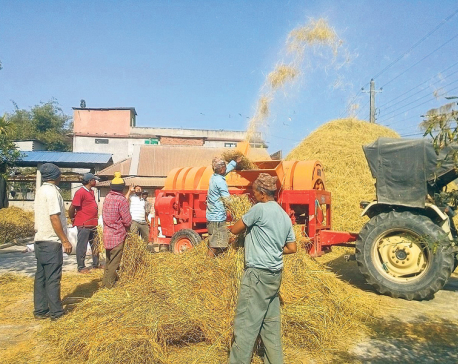
OR


Nahakul KC
The author is Executive Director of Poverty Alleviation Fund, Government of Nepal. Views are personal.news@myrepublica.com
More from Author
Mass job creation is key to our dream of prosperity. But this is possible only when we give priority to enterprise and entrepreneur development.
As the political transition that started in 2006 is soon going to be over, there is high hope that Nepal would finally be able to prosper. While local level elections under the framework of the new constitution have already been held successfully, provincial and federal polls are scheduled to be completed by mid-December 2017. These crucial elections will mark a new era, in which Nepal focuses solely on the agenda of prosperity after decades of political turmoil. As such, all the major parties in their manifestos have embraced the agenda of economic transformation and prosperity. Although we have been hearing a lot about the potential of agriculture, hydropower, tourism and human resources, there are a few other critical areas that merit serious attention to realize our aspiration for prosperity and development. This article highlights how some of these areas could prove to be a game-changer in our journey to prosperity.
Mass-scale job creation for youths is the key to realizing our dream of prosperity. This is possible only when we give priority to enterprise and entrepreneur development. Nepal had in the past launched ‘one village one product’ to promote enterprises and entrepreneurship at local level. With the country embracing a federal set up, we can now pursue similar, but more aggressive, program nationwide to produce at least one branded product from each Gau Palika and Nagar Palika. Government can facilitate this by imparting skill-oriented training to local youths. In the beginning, this may generate jobs for at least 100 youths in each local unit.
This could also help give important skills to youths who are aspiring to go abroad for work. Most Nepali youths who are headed out are illiterate, and only 1 percent of them are skilled. Worse, 25 percent of those recognized as skilled are only semi-skilled. Providing secondary education along with some skill-oriented training could help increase their earnings five times, thereby significantly increasing remittance inflow. Thus the promotion of enterprises and entrepreneurs will eventually contribute to job-creation jobs and increased incomes for ordinary folks.
Vital steps
This is, however, possible only if the government takes some measures, including: i) Providing training to 100,000 people on enterprise development and entrepreneurship; ii) creating at least 10,000 micro-enterprises and linking them to formal financial services; iii) building the capacity of community organizations and cooperatives; iv) providing start-up asset support such as seed money to budding entrepreneurs; v) creating better coordination and integration among various development stakeholders; vi) providing consulting and facilitation services and; vii) giving investment fund in the form of concessional loans.
Social protection measures are regarded as tools for stimulus and growth. Certain citizens are disabled, geographically isolated and even discriminated on the basis of their caste. Their life may also be affected by natural and human induced disasters. Social safety nets help such citizens, especially the poor and the vulnerable, cope with crises and shocks. Universal social protection coverage includes: social assistance through cash transfers to those in need, especially children; benefits and support for people of working age in case of maternity, disability, work injury or for those without jobs; and pension coverage for the elderly. The government has been supporting access to education and social protection, taking them as central to its goals of poverty-alleviation and shared prosperity. Although Nepal’s social protection coverage has increased significantly after 1990, this needs to be further enhanced.
Easy access to finance for all poor households and entrepreneurs is the key to ‘zero’ poverty. Our existing financial institutions must further enhance their outreach to remote areas and expand their investment areas. Nepal Rastra Bank, the central bank, can introduce some new policy measures in this regard. Some key activities that need to be carried out to improve sources of financing include financial literacy programs, helping target groups prepare business plans by training select members of cooperatives as well as community-based organizations, and mentoring cooperative members in business plans and in approaching banks for financial inclusion.
On the cusp
Linking the beneficiaries to financial institutions, mainly microfinance institutions (MFIs), at the policy as well as local levels and e-banking awareness sessions are important in this regard. Helping cooperatives be wholesale borrowers of microfinance institutions and providing training to cooperatives on financial management are equally important. Policy regulations and investment through the cooperative, which is one pillar of development, should be principle-based and focus on multi-dimensional aspects of poverty.
Nepal is now on the cusp of overcoming extreme poverty and economic transformation and prosperity. But for this we must change the current rules of game and devise innovative strategies. Our first strategy should be to recognize that recently elected 753 local governments are key game changer for local economic development, as they are tasked with providing services to citizens at the sub-national level. They are critically important to nurture and strengthen local economy. As our economy is currently heavily reliant on remittance, we should simultaneously pursue a strategy to minimize the contribution of remittance in our GDP and create an environment to tap skills and money brought by those returning from foreign employment.
Urbanization is growing, with over 60 percent of our population currently living in municipal areas. This is a blessing in disguise, as it creates opportunities to develop proper land use plans, promote industrialization and create jobs on a mass scale. They will prove to be game changer on the path to the country’s economic prosperity. Our next strategy should be to benefit from Nepal’s unique demographic dividend. Our country is blessed with the youth, with those aged 15-35 in majority. Each year, over 500,000 youths enter the job market.
Lastly, the government should develop strategies to promote technology and innovation, as they are crucial to enhance productivity of both manufacturing and service sectors, as well as nurture and strengthen their links to the financial sector.
Major political parties including the Nepali Congress (NC)-led ‘democratic’ alliance and the CPN-UML-led left alliance have already unveiled their manifestos, putting strong emphasis on economic transformation and prosperity. Nepal needs to create jobs through promotion of entrepreneurship and enterprise, and by shifting its focus from ‘poverty model’ to ‘economic growth model’. It is high time our political leadership realized the importance of these sectors to deliver on the promises they have made on the campaign trail.
The author is Executive Director of Poverty Alleviation Fund, Government of Nepal. Views are personal.
You May Like This

Road to riches
Agriculture has the potential to spur development in our hills and mountains with their vast agro-climatic variations ... Read More...

Mourinho 'too young' to be tempted by Chinese riches
Wealthy Chinese clubs are unlikely to lure Jose Mourinho away from England as the Manchester United manager says he is... Read More...





Just In
- 286 new industries registered in Nepal in first nine months of current FY, attracting Rs 165 billion investment
- UML's National Convention Representatives Council meeting today
- Gandaki Province CM assigns ministerial portfolios to Hari Bahadur Chuman and Deepak Manange
- 352 climbers obtain permits to ascend Mount Everest this season
- 16 candidates shortlisted for CEO position at Nepal Tourism Board
- WB to take financial management lead for proposed Upper Arun Project
- Power supply to be affected in parts of Kathmandu Valley today as NEA expedites repair works
- Godepani welcomes over 31,000 foreign tourists in a year






_20220508065243.jpg)







Leave A Comment